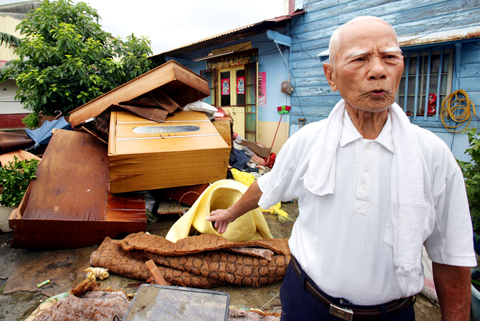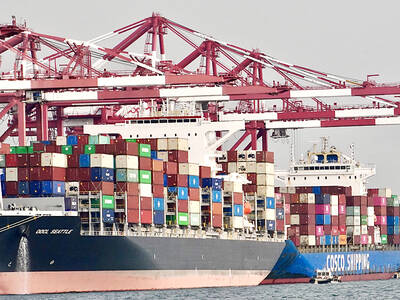Relief workers continued search and rescue operations yesterday after Tropical Storm Kalmaegi wreaked havoc in southern and central Taiwan the previous day.
Casualties from floods and mudslides were reported in the worst-hit areas in central and southern Taiwan, where up to 950mm of rain fell in less than two days, the National Fire Agency said.
Nearly 60,000 government and civilian rescuers have been mobilized to combat floods, conduct rescue missions and help clear thick mud that covered roads and filled residences, it said.

PHOTO: CNA
As of press time, the death toll was 18, with the latest casualty an elderly woman who was earlier reported to be missing after falling into a river while riding her motorcycle in Pingtung County yesterday morning, the National Disaster Response Center said.
Seven people, believed to have been washed away by floods or buried alive, remained missing, while eight others were injured, it said.
Kaohsiung County suffered the heaviest human toll nationwide, with eight fatalities, seven missing and five injured, followed by Tainan County with three fatalities and three injured.
The other two deaths occurred in Chiayi and Miaoli counties.
At least five low-lying areas in central and southern Taiwan were still inundated by floods brought by torrential rains, the center said.
Utilities in southern Taiwan have also been interrupted, with 12,994 households still without electricity and 268,473 homes without running water. The center expected power and water to be resorted by last night.
Kalmaegi also ravaged fields and farms. Council of Agriculture statistics showed losses reaching NT$581 million (US$19.1 million) as of 4pm yesterday, with the majority — or NT$445 million — coming from damage to crops.
By region, Yunlin County was the hardest hit, suffering losses totaling NT$101.82 million, making it eligible for subsidies and low-interest loans under the country’s disaster relief laws.
The second hardest-hit area was Tainan County, recording losses amounting to NT$94.97 million, followed by Kaohsiung County with NT$49.13 million, Nantou County with NT$45.25 million, Changhua County with NT$31.85 million and Taichung County with NT$28.64 million.
Chu Jin-shi (朱金錫), the council’s chief of farmers’ welfare, urged farmers who qualify for relief under the law to take advantage of the subsidies to get back on their feet.
The Environmental Protection Administration (EPA) yesterday urged the public to clean up flooded areas in their neighborhood to prevent the spread of diseases, including dengue fever.
“Environmental protection units formed emergency environmental disaster response centers across the country as soon as Kalmaegi struck on Friday,” said Yuan Shaw-ying (袁紹英), director-general of the EPA’s environmental sanitation and toxic substance management department.
“Cleaning and disinfecting work began nationwide yesterday,” he said.
Yuan said the EPA had ordered its subordinate units to finish the cleanup by tomorrow when people begin to go back to work or school.
Places that would collect puddles of water, such as flower pots or gutters, should be kept dry, Yuan said.
“Since the Aedes aegypti mosquito sometimes lays eggs on the outer rims of water containers, it is important to scrub the places you clean, in addition to pouring the water out,” he said.
President Ma Ying-jeou (馬英九), faced with the first major natural disaster since his May 20 inauguration, blamed the lack of preparedness for the storm on the Central Weather Bureau (CWB), which he said provided an inadequate warning.
In response, Daniel Wu (吳德榮), director of the CWB’s weather forecast center, told reporters that “a margin of error is inevitable” in weather forecasting.
The CWB yesterday urged residents in central and southern Taiwan to brace for further downpours although the storm was moving toward the Chinese province of Fujian.
If Kalmaegi had a silver lining after its torrential rains devastated central and southern Taiwan on Friday, it would be the abundant water it poured into local reservoirs to ensure a drought-free year.
The Water Resources Agency said that Tsengwen Reservoir (曾文水庫) in Tainan County — the largest reservoir in the country — collected 310 million tonnes of water within one day, increasing its level from 40 percent to 92.4 percent full.
The reservoir’s administration said it was prepared to open the dam’s floodgates yesterday if the reservoir continued to fill up.
Nanhua Reservoir (南化水庫), also in Tainan County, opened it sluice gates on Friday when it reached its maximum storage capacity of 141.84 million cubic meters.
Beihe Reservoir (白河水庫), which is mainly used for irrigation of the Tainan area, was filled to capacity on Thursday night and its administration officials immediately opened the floodgates.
Shihmen Reservoir (石門水庫) in Taoyuan County also began to adjust its water level around noon on Friday. As of press time, the water level had reached the 241m mark — only 4m below the maximum level — representing 83.63 percent of the reservoir’s storage capacity.

The Central Weather Administration (CWA) yesterday said it expected to issue a sea warning for Typhoon Fung-Wong tomorrow, which it said would possibly make landfall near central Taiwan. As of 2am yesterday, Fung-Wong was about 1,760km southeast of Oluanpi (鵝鑾鼻), Taiwan’s southernmost point, moving west-northwest at 26kph. It is forecast to reach Luzon in the northern Philippines by tomorrow, the CWA said. After entering the South China Sea, Typhoon Fung-Wong is likely to turn northward toward Taiwan, CWA forecaster Chang Chun-yao (張峻堯) said, adding that it would likely make landfall near central Taiwan. The CWA expects to issue a land

Taiwan’s exports soared to an all-time high of US$61.8 billion last month, surging 49.7 percent from a year earlier, as the global frenzy for artificial intelligence (AI) applications and new consumer electronics powered shipments of high-tech goods, the Ministry of Finance said yesterday. It was the first time exports had exceeded the US$60 billion mark, fueled by the global boom in AI development that has significantly boosted Taiwanese companies across the international supply chain, Department of Statistics Director-General Beatrice Tsai (蔡美娜) told a media briefing. “There is a consensus among major AI players that the upcycle is still in its early stage,”

‘SECRETS’: While saying China would not attack during his presidency, Donald Trump declined to say how Washington would respond if Beijing were to take military action US President Donald Trump said that China would not take military action against Taiwan while he is president, as the Chinese leaders “know the consequences.” Trump made the statement during an interview on CBS’ 60 Minutes program that aired on Sunday, a few days after his meeting with Chinese President Xi Jinping (習近平) in South Korea. “He [Xi] has openly said, and his people have openly said at meetings, ‘we would never do anything while President Trump is president,’ because they know the consequences,” Trump said in the interview. However, he repeatedly declined to say exactly how Washington would respond in

Japanese Prime Minister Sanae Takaichi said yesterday that China using armed force against Taiwan could constitute a "survival-threatening situation" for Japan, allowing the country to mobilize the Japanese armed forces under its security laws. Takaichi made the remarks during a parliamentary session yesterday while responding to a question about whether a "Taiwan contingency" involving a Chinese naval blockade would qualify as a "survival-threatening situation" for Japan, according to a report by Japan’s Asahi Shimbun. "If warships are used and other armed actions are involved, I believe this could constitute a survival- threatening